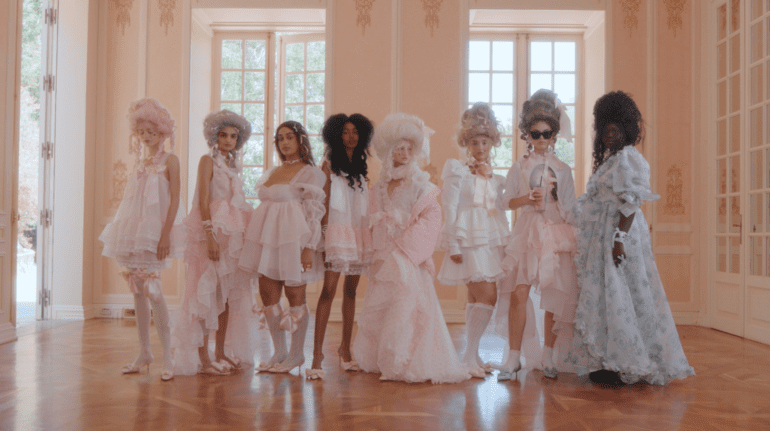TL;DR:
- Selkie, a ‘slow fashion’ brand, faces scrutiny for using generative AI in its designs.
- The brand defended its AI integration, highlighting the evolving landscape of AI in fashion.
- Many fashion brands, including Valentino, Prada, and Gucci, have embraced generative AI for various purposes.
- AI Fashion Week in New York showcases the latest in AI-generated fashion designs.
- H&M and others actively incorporate AI for product design and customization.
- Experts emphasize that AI won’t replace human creativity but will enhance collaboration.
- Transparency is key when employing AI in fashion to maintain consumer trust.
- Ethical concerns arise when AI-generated designs overshadow human creativity.
Main AI News:
Selkie, a prominent fashion brand renowned for its commitment to “slow fashion” and sustainability, has recently raised eyebrows by incorporating generative AI into its design process. On January 17th, the Chinese company unveiled its 2024 Valentine’s Day collection, titled “Home Is Where the Heart Is,” via an Instagram post. While showcasing their latest creations, Selkie enthusiasts couldn’t help but notice a peculiar anomaly in one design – a puppy with an unusual number of toes.
Critics swiftly took to the comment section to lambaste the brand for its adoption of AI in the creative process. In response, Selkie issued a statement regarding the growing role of AI in the fashion industry.
“The debate surrounding AI-generated art remains divisive, with some artists embracing it and others opposing it,” noted a Selkie spokesperson in their Instagram response. “As artists who appreciate technological advancements and witness AI’s integration into various brand strategies, we felt it was essential to explore this innovative medium and its potential impact on Selkie as a brand and Kimberley Gordon as an artist,” they elaborated, referencing Selkie’s founder and her involvement in AI-generated creations. Additionally, the brand emphasized its commitment to staying ahead of industry trends rather than lagging behind.
Selkie joins a growing list of fashion houses that have incorporated generative AI into their operations. In 2023, Valentino utilized AI-generated visuals for its Essential campaign, while Prada and Gucci employed AI in their advertising efforts. Levi’s ventured into the realm of digital models for its e-commerce platform, a move that sparked controversy for its use of AI-generated human images instead of human models, though it justified it as a means to promote greater diversity.
Notably, some fashion brands have gone beyond mere advertising and have used AI to create entire collections. This trend has culminated in the emergence of an AI Fashion Week in New York, dedicated to showcasing the latest AI-generated designs. Fast-fashion giants like H&M have fully embraced the technology, enabling customers to design their own clothing items, which are subsequently produced using the brand’s generative AI platform, Stable Diffusion. A 2023 McKinsey report even suggests that the incorporation of generative AI could contribute approximately $275 billion to the operating profits of the apparel, fashion, and luxury sectors.
The prospect of increased revenue is undeniably a driving force for brands, yet experts reassure that there’s no need for alarm. Rajiv Narayana, CEO of the US-based learning-design company ansrsource, urges us to remember that “like any new innovation,” the potential of AI is often “exaggerated, while the speed of change is underestimated.” Narayana believes that AI won’t supplant human creativity but will instead lead to more harmonious collaborations between humans and machines in the creative process.
Hikari Senju, founder and CEO of California-based advertising-personalization firm Omneky, echoes this sentiment. He draws parallels between AI and the introduction of Photoshop three decades ago, acknowledging initial disillusionment when people discovered images were digitally manipulated. However, Senju highlights that it also ushered in a new era of creativity among artists. He emphasizes the importance of transparency in AI utilization by companies.
Nonetheless, using AI to directly generate clothing designs, as opposed to just advertisements, can pose a challenge for consumers seeking original, ethically produced creations. This is especially true when it involves a brand that prides itself on ethical manufacturing practices. Meghan Fulton, an independent designer with experience working for New York City designers and now the owner of an upholstery company, acknowledges the complexity of the issue. She notes that while AI can serve as a source of inspiration, its application on the creative side can cause friction when brands underestimate the discerning nature of today’s consumers.
Fulton, however, does not view the use of AI in fashion design, even for slow-fashion brands, as inherently objectionable, provided that these companies collaborate with real human designers rather than solely relying on AI. Judging from the comments on Selkie’s criticized Instagram posts, many of their followers share this perspective.
Conclusion:
Selkie’s adoption of generative AI reflects a broader trend in the fashion industry, where technology is becoming increasingly intertwined with creative processes. While AI offers innovative possibilities and potential revenue boosts, brands must prioritize transparency and ethical considerations to maintain consumer trust. Collaborations between AI and human designers are likely to define the future of fashion, rather than AI replacing human creativity entirely.

